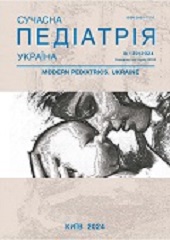Peculiarities of metabolic cardioprotection in children with anthracycline cardiomyopathy
DOI:
https://doi.org/10.15574/SP.2024.139.54Keywords:
acute leukemia, chemotherapy, doxorubicin, cardiomyopathy, childrenAbstract
Protocol chemotherapy of acute leukemia in children involves the use of cardiotoxic drugs, in particular anthracycline antibiotics. Pathomorphological lesions of the heart in such patients can form heart failure. Modern theories of the pathogenesis of anthracycline cardiomyopathy in children highlight only certain aspects of its development, which requires the study of pathogenetic links, early clinical diagnostic markers and their effective correction.
Aim - to establish early diagnostic criteria for heart damage in children with acute leukemia on the background of cardiotoxic therapy.
Materials and methods. 70 children with acute leukemia treated according to ALL IC BFM 2009 protocols were examined. They were examined at the pre-protocol stage, at the end of the first phase I and II protocols. According to the cumulative dose of doxorubicin, patients were divided into I and II groups. Each of the groups, in turn, was divided into subgroups (with cardioprotection and without cardioprotection). For the purpose of cardioprotection, an L-carnitine-containing preparation was used.
Results. It has been established that oxidative stress develops in patients with acute leukemia as a result of the use of anthracyclines, which is accompanied by the activation of antioxidant defenses. In addition, there are manifestations of energy deficiency with a predominance of anaerobic glycolysis. Manifestation of acute leukemia was an increase in natriuretic hormone. The influence of the cumulative dose of doxorubicin on the cardiovascular system in children with acute leukemia was analyzed, and metabolic cardioprotection with an L-carnitine-containing drug was also performed.
Conclusions. The formation of cardiotoxic lesions of the myocardium in the form of anthracycline cardiomyopathy in patients with acute leukemia receiving protocol chemotherapy leads to a 4.5-fold increase in the level of natriuretic hormone already at the end of the first phase I of the protocol. At the same time, the maximum values of the heart failure marker are characteristic of children who received a higher cumulative dose of anthracycline at the end of protocol chemotherapy. It has been established that cardioprotection with an L-carnitine-containing drug stabilizes the indicators of protein and lipid peroxidation by two times, reduces the manifestations of myocardial energy deficiency, and lowers the level of the heart failure marker.
The research was carried out in accordance with the principles of the Helsinki Declaration. The study protocol was approved by the Local Ethics Committee of the participating institution. The informed consent of the patient was obtained for conducting the studies.
The authors declare no conflict of interest.
References
Alvarez-Cardona JA, Zhang KW, Mitchell JD et al. (2020). Cardiac biomarkers during cancer therapy. Cardiooncology. 2(5): 791-794. https://doi.org/10.1016/j.jaccao.2020.08.014; PMid:34396295 PMCid:PMC8352269
Armenian S, Bhatia S. (2023). Predicting and preventing anthracycline-related cardiotoxicity. American Society of Clinical Oncology: 3-12. https://doi.org/10.1200/EDBK_100015; PMid:30231396
Ballesteros AL, Lobo RS, Valencia JC et al. (2021). Early-onset Cardiotoxicity assessment related to anthracycline in children with leukemia. A prospective study. Colombia Médica. Feb. 15: 1-14. http//doi. org/:10.1025100/cm.v52il.4542.
Desai L, Balmert L, Reichek J et al. (2019). Electrocardiograms for cardiomyopathy risk stratification in children with anthracycline exposure. Cardio-Oncology. 5: 1-10. https://doi.org/10.1186/s40959-019-0045-6; PMid:32154016 PMCid:PMC7048097
Gupta SK, Garg A, Avramopoulos P et al. (2019). miR-212/132 mluster modulation prevents doxorubicin-mediated atrophy and cardiotoxicity. Molecular Therapy. 27 (1): 17-28. https://doi.org/10.1016/j.ymthe.2018.11.004; PMid:30527757 PMCid:PMC6319305
Hegazy M, Ghleb S, Das BB. (2023). Diagnosis and management of cancer treatment-related cardiac dysfunction and heart failure in children. Children. 10, 149: 1-18. https://doi.org/10.3390/children10010149; PMid:36670699 PMCid:PMC9856743
Lazаr DR, Farcaş AD, Cristina Blag C et al. (2021). Cardiotoxicity: a major setback in childhood leukemia treatment. Hindawi: 1-9. https://doi.org/10.1155/2021/8828410; PMid:33505537 PMCid:PMC7810535
Leerink JM, de Baat EC, Elizabeth AM et al. (2020). Cardiac disease in childhood cancer survivors. Cardiooncology. 2(3): 363-378. https://doi.org/10.1016/j.jaccao.2020.08.006; PMid:34396245 PMCid:PMC8352294
Lipshultz SE, Law YM, Asante-Korang A, Austin ED et al. (2019). Cardiomyopathy in children: classification and diagnosis. Circulation. 139: 00-00. https//doi.org/10.1161/CIR.0000000000000682.
Mancilla TR, Iskra B, Aune GJ (2020). Doxorubicin-Induced Cardiomyopathy in Children. Compr Physiol. 9(3): 905-931. https://doi.org/10.1002/cphy.c180017; PMid:31187890 PMCid:PMC7000168
Nathan P, Kulkarni K, MacDonald T. (2022). Incidence and risk factors of anthracycline-induced cardiotoxicity in long-term survivors of pediatric cancer: A population based cohort study. Pediatric Hematology Oncology Journal. 7: 136-141. https://doi.org/10.1016/j.phoj.2022.06.004
Rhee JW, Ky B, Armenian SH, Yancy CW et al. (2020). Primer on biomarker discovery in cardio-oncology. Cardiooncology. 2(3): 379-384. https://doi.org/10.1016/j.jaccao.2020.07.006; PMid:33073248 PMCid:PMC7560982
Samura BB, Panasenko MO. (2020). Sercevo-sudynni uskladnennya polichimioterapiyi mnozhynnoyi miyelomy: suchasni napryamy v diagnostyci. Aktual'ni pytannya pharmacevtychnoyi і medychnoi nauky ta praktyky. 1(32): 164-172. https//doi.org/10.14739/2409-2932.20-2020/1/198217.
Simioni C, Zauli G, Martelli AM et al. (2018). Physical training interventions for children and teenagers affected by acute lymphoblastic leukemia and related treatment impairments. Oncotarget. 9(24): 17199-17209. https://doi.org/10.18632/oncotarget.24762; PMid:29682216 PMCid:PMC5908317
Wang DD, Cheng RK, Rong Tian R. (2021). Combat doxorubicin cardiotoxicity with the power of mitochondria transfer. Cardiooncology. 3(3): 441-443. https://doi.org/10.1016/j.jaccao.2021.08.001; PMid:34604805 PMCid:PMC8463719
Zheng Tan VZ, Chan NM, Wai Lin Ang et al. (2021). Cardiotoxicity after anthracycline chemotherapy for childhood cancer in a multiethnic population. Frontiers in Pidiatrics. Feb. 03: 1-9. https://doi.org/10.3389/fped.2021.639603; PMid:33614560 PMCid:PMC7888269
Downloads
Published
Issue
Section
License
Copyright (c) 2024 Modern pediatrics. Ukraine

This work is licensed under a Creative Commons Attribution-NonCommercial 4.0 International License.
The policy of the Journal “MODERN PEDIATRICS. UKRAINE” is compatible with the vast majority of funders' of open access and self-archiving policies. The journal provides immediate open access route being convinced that everyone – not only scientists - can benefit from research results, and publishes articles exclusively under open access distribution, with a Creative Commons Attribution-Noncommercial 4.0 international license (СС BY-NC).
Authors transfer the copyright to the Journal “MODERN PEDIATRICS. UKRAINE” when the manuscript is accepted for publication. Authors declare that this manuscript has not been published nor is under simultaneous consideration for publication elsewhere. After publication, the articles become freely available on-line to the public.
Readers have the right to use, distribute, and reproduce articles in any medium, provided the articles and the journal are properly cited.
The use of published materials for commercial purposes is strongly prohibited.

